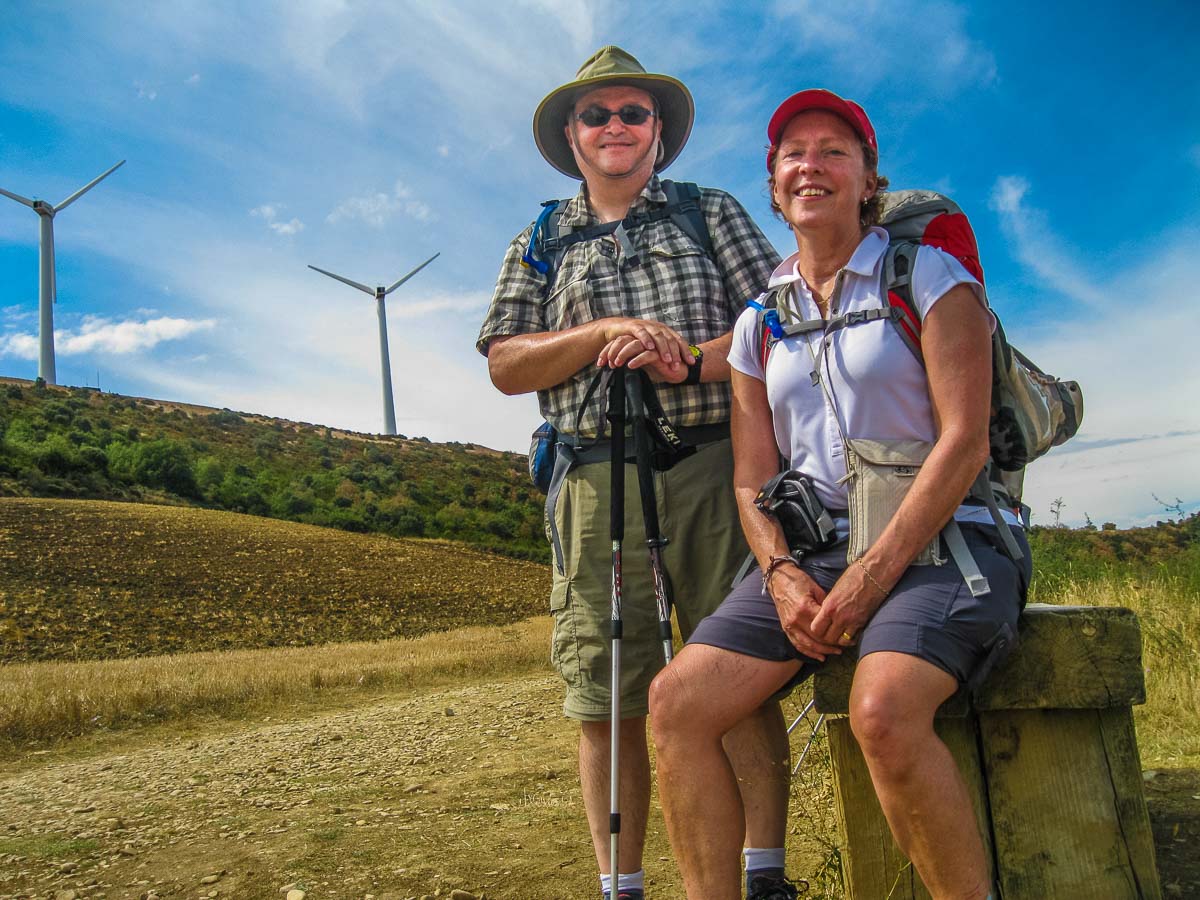
Kris and I walked the 800 km (500 miles) of the Camino Francés (French Way) route from Saint Jean Pied de Port to Santiago de Compostela in 40 days from late August to early October 2011. Since then, we've also done parts of the Camino Lebaniego in Cantabria, and stretches on the Northern Camino route across Asturias and the rest of northern Spain. Tom has also done large parts of the Way of Saint Olav in Sweden and Norway. We've also hiked for days through the Guatemalan jungle.
Combine those treks with the days we've spent hiking in our home state of Minnesota, and we have a lot of recommendations for making your Camino as pleasant as possible – at least from the perspective of a Camino packing list. The other stuff about the Camino, you'll have to work out on your own.
Certainly one of the questions about the Camino we're asked the most is, please give me your Camino de Santiago packing list. So, here is is. Note: we've devoted separate posts to the Camino backpack itself and Camino footwear and footcare, which deserve their own posts.
So, here's a complete Camino packing list of all of (ok, most of) the gear you'll want on the Camino.
Table of Contents
The Backpack
As I said above, I have dedicated an entire post to the best backpack ideas for the Camino, but in short, if I were doing it today and starting from scratch, I'd go with the Osprey Talon 44L backpack. It has all the features I want in a pack: pockets on the hip straps for small items like your knife, sunscreen, money and credit cards, etc., adjustable torso length, cool web back, separate top and exterior pockets, and lots of attachment points for carabiners, straps to carry your walking sticks, a hydration sleeve, and more. It's also very light, coming in at either a bit over or under 3 pounds (1.36kg) depending on whether you get the smaller (42L) or larger (44L) size. The main consideration there is your torso length, not capacity. Get the one that fits you.
If you can fit everything you need into 30 liters, look into the Six Moons Flight 30 Ultra Running Backpack. You can pick from three styles of shoulder harnesses and two sizes of lap belts to make it fit just as you like. Also, the attachment point of the shoulder harness is pretty much infinitely adjustable, so you can fit your torso length perfectly. And, it's the lightest backpack ever, only 31 ounces (878 grams.)
You'll see your fellow pilgrims carrying all sizes of backpacks from huge camping style rigs to tiny daypacks. (The latter are the people who are sending their luggage ahead every day and staying in private rooms. No judgement, but that's not the kind of Camino I'm talking about here.) The best advice is to layout all the gear you'll be carrying, and pick the smallest, lightest, and sturdiest backpack that will fit that gear.
Another idea regarding your pack is to carry a small lightweight day pack to use for exploring the towns where you'll be stopping and when you don't want to carry your main pack around. This one folds down tiny and weighs only 2.5 ounces (71 grams.)
 Want more tips like these?
Want more tips like these?
Join the 3500 other travel enthusiasts getting our best advice right in their inbox. And get our 50 best travel tips sent to you right away!
Shoes
Adidas Terrex trail shoes
The first word about walking shoes is that you should find shoes that fit you. Period. Different feet like different shoes. I recommend the Adidas Terrex and Xero brands because they're what work for me. I have wide feet, and both of these brands feature wider than usual toe boxes, which I like. Please read this more detailed post on shoes and foot care for the Camino before you choose your shoes.
Adidas Terrex (or at least their precursors) are the shoes I wore on my Camino. And I still have two pairs that I often wear on the frequent day hikes we take. They're rugged, have harder soles with good traction, but aren't so heavy that you'll regret lugging your feet around in them. As I mention in the shoe post, I don't think you need high-ankle hiking boots for the Camino unless you're particularly prone to rolling your ankles.
Essential bit of advice: buy shoes one size larger than your usual. Your feet will expand on the Camino. Trust me on this.
More essential shoe advice: do not buy Goretex or other waterproof shoes. Your feet need to breathe. Sweaty feet enclosed in non breathable shoes is the recipe for blisters. The above mentioned Guatemala expedition was a bitter lesson of this point.
Xero trail shoes
Another brand of hiking shoes I've really like are Xero. Xero's basic philosophy is extreme light weight, extreme flexibility, big toe box, and the “barefoot feel” of minimal heel elevation.
For the Camino and heavier duty hiking, though, I'd go with the Xero Mesa Trail II, which, as the name suggests, is a trail shoe. (Here's the women's version.) I have recently tried this model on a hike up a volcano in the Canary Islands and I found them to be all that they promised: light, breathable, grippy on uneven terrain. One caveat, the “barefoot feel” means the soles are a lot thinner than the Adidas, so the feel of the ground comes through more. If you have particularly sensitive feet, these will take some getting used to. But now that I have got used to them, the Xero is my new favorite.
Another thing I love about the Xero website is their “find your shoe” feature, which prompts you with some questions about your shoe use and then will suggest the shoes that meet your needs.
Flip flops
You aren't going to be wearing these on the trail, but you will be happy for a comfortable pair of Teva flip flops to wear after the day's hiking is done. There's nothing better than letting your feet really cool off when you can. Get ones that can also double as shower shoes.
Clothing
Socks
There are lots of good socks out there, and we've talked about several brands in our shoes and socks post. But, if I had to pick just one brand I'm very happy with, I'd go with Point6. Pick the weight that works for you, and that will depend on the weather when you're walking and how much cushioning you prefer. I particularly like then Point6 Merino wool heavy hiking socks. If you favor a lot of padding, these are for you. I wore them for several days hiking the St. Olav's pilgrimage in northern Sweden. If anything, that might be a tougher test than the Camino de Santiago. I've used them on a couple of day hikes around the Twin Cities area so far, and the short story is I love them. I also wore these socks on several 10-kilometer hikes on hot days in the African bush.
One thing I particularly like about the Point6 is their fit. They seem a little tighter and molded to my foot. In addition to providing a bit more arch support, that also means they slide around in the shoe a bit better, and that's a friction reducer. Like I said, the heavier weight socks might not be right for you. Pick the light or medium weight, if that's more to your liking.
Underwear
As with all your clothes, you want lightweight, breathable, and quick drying. I’m a big fan of the ExOfficio brand and wore their ExOfficio Men's Give-N-Go Boxer many days. They were supremely comfortable, and they dried fast.
Kris wore ExOfficio Women's Give-N-Go Bikini Briefs and said they were great.
T-shirts
I wore Under Armour Tech t-shirts and they were just fine. There are lots of t-shirts that wick sweat so you can certainly pick your own. Don't wear cotton shirts. They actually end up making you hotter. And when you wash them at the end of the day, they dry very slowly. The “tech” shirt dries quickly after washing.
I'd also recommend going with light colors. Light colors are a lot better in the heat.
Another alternative, of course, is merino wool. We like the Unbound Merino brand.
Take at least two, and probably three t-shirts. There are those days when you might want to change midday. Also, an extra shirt will be a backup if yesterday's shirt hasn't dried yet.
Long sleeved shirt
There are some days you may want a warmth layer, especially when you hit the higher elevations in Galicia. To our minds, nothing beats the Unbound Merino long sleeve shirt for that use. One shirt should be plenty, and the big benefit of merino is you don't need to wash it every time you wear it.
Shorts
I prefer to hike in shorts. And the REI Trailmade hiking shorts are as good as any. They're comfortable, durable, and they dry quickly after washing. And, they're not too expensive. I don't worry too much about starting out in shorts, even on cooler days.
Long pants
Lately, I've become very partial to the Kuhl Renegade pants. On a cool day, you can start out in them. Or, save them to wear in the evenings when you're hanging around town and having dinner and drinks with your new Camino friends. Like the other technical clothes, they dry quickly, should you need to wash them. And they look a lot nicer than your usual cargo pants type of hiking trousers. A less stylish, and cheaper, alternative is the REI Trailmade hiking pants in the long version.
Hat
You want something to shade your face. So at minimum, a baseball cap will do. (I saw one guy who had cut up a t-shirt and sewed it to the back of a ball cap to cover the back of his neck.) I wore a broad brimmed Tilley Endurables LTM6 Airflo Sun Hat, which shades not only your face, but your whole head and neck. It has a great sweatband, and, one of my favorite features, ties front and back, which make it pretty impossible to blow off your head. It’s washable and dries quickly. Often on hot days, I would soak it in a fountain, shake it off and wear it. It felt great. I can't say enough for this hat. It's perfect, indestructible, and guaranteed forever. I've had mine for 18 years.
Rain gear
There are two approaches to rain gear, and each has its advantages. You can carry a rain jacket like we did. Or you can opt for a a rain poncho that will serve to cover you and your pack. The poncho will save you from having to have a separate rain cover for your pack. The advantage of a good quality breathable rain jacket like the Patagonia Torrentshell rain jacket that we favor will also serve as a warmth layer for the rare Spanish day when you need that.
Sleeping
Silk blend liner
You probably won't need a sleeping bag. Instead, buy a very light and washable Sea to Summit Adaptor CoolMax Sleeping Bag Liner, which is great for the albergues. When you're cold, you can usually get a blanket from the albergue. By the way, it's a good idea to treat this (and your optional sleeping bag) with Permethrin insect repellent just in case you're unlucky enough to run into bed bugs.
Gym shorts
I slept in tomorrow's clean t-shirt and a pair of Vuori gym shorts. I like the Vuori brand. They double as swim trunks, if the urge to have a dip strikes you along the way. (Yes, the occasional albergue will have a pool.)
Earplugs
The thing on your Camino packing list you'll be especially glad you carried are ear plugs. Many options are available, up to and including custom fitted ones that cost a couple of hundred dollars. Or you can buy a bag of a hundred disposable foam ones at Amazon or at any hardware store. I did the latter, and handed them out in pairs to other pilgrims along the way. The only alternative to ear plugs would to be to strangle the snorers in your albergue, but that’s frowned upon.
Eye mask
There are plenty of sleep eye masks out there, but these contoured sleep masks are more comfortable. The contour holds the mask material off your eyelashes: a small but significant improvement in comfort.
Sleeping bag
If you are a cold sleeper, you could bring a very lightweight sleeping bag for those unusual cold nights. (We didn't feel cold at night until we got to the higher elevations in Galicia.) This one should keep you warm down to 40 degrees F (5C) and weighs less than two pounds (about 570 grams.) Like I said, you probably won't need it, but just in case, or if you don't like scratchy albergue blankets, you could add a little extra weight.
Toiletries
I shouldn't need to tell you what toiletries you'll need. I did find an olive oil soap bar that worked for me for both body and shampoo. And I shave in the shower, so I don't need a separate shave cream. A travel toothbrush or at least a cap that covers the toothbrush head is a good idea. Any toiletries you may need are easily available in any Spanish town. I do like the Sea to Summit lightweight hanging toiletry bag, which has plenty of pockets for keeping things straight.
I also have a super light weight Eagle Creek toiletry bag just for my medicines.
First Aid
We have a whole post about constructing a travel first aid kit. So please refer to that. Also, keep in mind that it's likely that foot blisters will be your main annoyance. So, be sure to look at the specifics in this post for dealing with blister prevention and treatment.
Tech
Smart phone
I probably can't tell you anything about your cell phone you don't already know. I certainly wouldn't buy a new one just for the Camino. One feature you should probably be aware of though is having either a virtual or second SIM slot, or be willing to pay for an international plan, if you want your phone to work in Spain. I'm also presuming you're going to want to use your phone's camera.
Charger and cables
Don't forget to get a combination plug adapter and portable charger with multiple USB ports to keep your various devices charged. We like this charger because it charges much faster than a lower wattage version. Keep in mind that plugs are at a premium in alberges, so be aware you may have to wait your turn to charge, so speed is a big plus. Also, the cheap cables that come with your devices (especially Apple) are lousy. We like Anker 100w cables. Be sure your cables wattage match your device's needs.
Watch or Fitbit
Again, a matter of personal preference. (I use an Apple Watch.) It counts your steps, among other things. And seeing a big number at the end of a long day is a reward in and of itself.
Auxiliary power
Always a good idea if you're relying on your phone to a large degree for things like mapping, music, or whatever is an auxiliary power battery.
Earbuds
I didn't use earbuds on the Camino because instead of music or podcasts, I preferred to listen to the crunch of my own feet on the path. But, in case you want a little music along the way, or want to relax a bit after a long day walking, maybe these Jabra ear buds are the right ones for you. I use these on my shorter walks around town and like them a lot.
Kindle
I must admit I like reading more than listening to music or podcasts so I won't travel without a reading device. the lightest one is an Amazon Kindle.
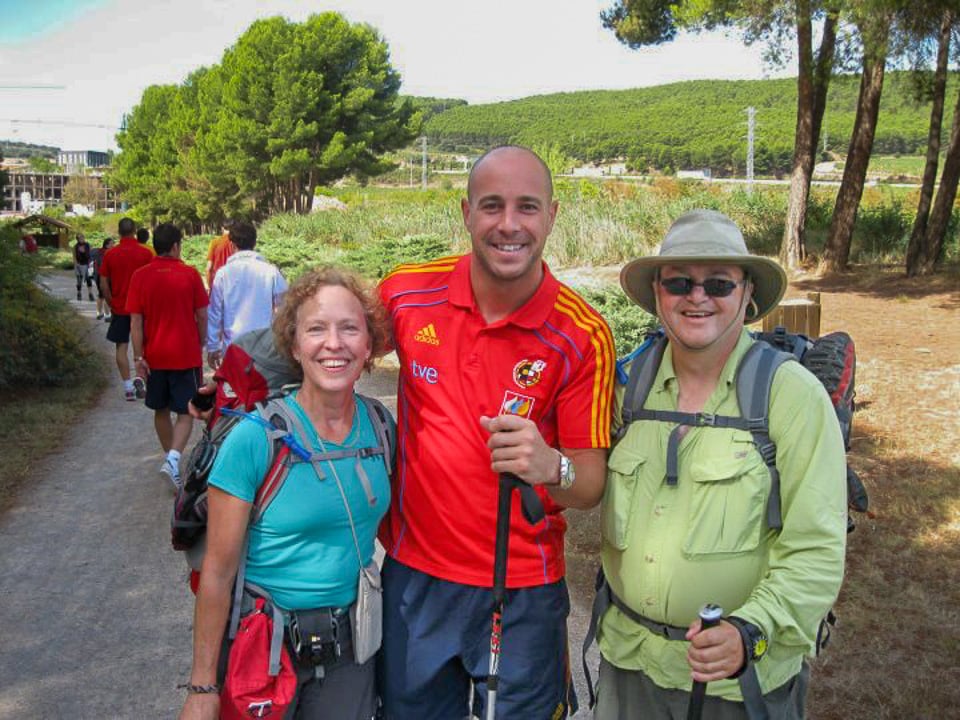
Miscellaneous
Knife or multi-tool
You'll want a knife for sure, and perhaps a multi-tool. There are lots of multi-tools available, and I often carry the Leatherman Skeletool. (I actually did have one instance on the Camino when I needed the pliers when I had to do a little work on my hiking stick.) But, if you want a great multi-purpose knife, this is the Swiss Army knife that is actually carried by Swiss soldiers. It's substantial. It's a bit heavy, but I love it.
Headlamp
You will need a headlamp for getting around the albergues after lights out and before lights on. Also, if you’re one of those pilgrims who start walking in the very early mornings before the sun is up, you’ll need one as soon as you get out of the light of the town. The Black Diamond Spot 400 Headlamp is pretty much like the one I had. Black Diamond makes a great line of headlamps with various features, some of which are cheaper than this one. Look for a three way switch with high and low intensity beams and a red night light. The red night light is for use around the albergue so you could see without waking up your neighbors. There are so many variations, and the technology allows you to have extremely bright lights of hundreds of lumens, if you want. Check around to find the lamp that best suits you. But for the Camino, this one should do the trick.
Sunglasses and case
Sunglasses are a personal preference. Pick your own. But get good ones. Spain is sunny. A light hard glasses case is good for storing your sunglasses (or regular glasses) at night.
Water bladder/bottle
We prefer a hydration bladder that is carried in our pack when actually walking. It's a lot easier to bring a tube to your mouth to drink, and because it's easier, you'll drink more while you're walking. And that's a good idea. But there are some that prefer a water bottle, and if your pack has side pockets for carrying it – and you can get to it easily without removing your pack – that's your choice. There are usually, but not always, lots of places to refill your bottle as you walk through towns.
Laundry kit
An essential item of your Camino list is a laundry kit. That’s a clothes line, clothes pins (probably about six), a flat sink stopper, and laundry soap. (It's unlikely you'll have the use of a washing machine anywhere on the Camino.) The clothes line is rarely necessary, as most albergues have clothes lines, but if you stay in a hostel or a hotel occasionally, you’ll need it.
About three meters (10 feet) of plastic cord is great. Don’t buy the one in the travel store. It’s stretchy, which you’ll find you actually don’t want, and it costs about $8. The plastic cord will be about $2 at the hardware store, and you can tie your own knots instead of using the sticky plastic things on the end of the expensive clothesline that don’t work anyway. You may not be able to buy only the length you’ll need, but just cut off what you do need from the 50-foot package. Be sure to melt the cut end with a match so it won’t unravel.
The same purchasing advice goes for the flat sink stopper. You can get one of those in the travel store for about $5, or in a hardware store for about $2. Or, there's a Travel Sink Plug for Laundry at Amazon for about $3.
As for clothes pins, plastic are lighter than wood, although, believe it or not, I went to three stores looking for them before I finally gave up and settled for wood. You'll only need about six of them, but good luck buying fewer than 50.
You can buy a small bottle highly concentrated liquid laundry detergent in the outdoor or travel store, too, and I did. However, you’ll run out about half way through the Camino. The better solution is to buy laundry bar soap, which is actually easy to find in Spain. Another alternative is to get these Earth Breeze laundry detergent sheets. Figure out how many days you'll be on the Camino and take just that many sheets with you in a Ziplock bag. Each sheet can do two small loads, btw, so be sure to actually take half as many full sheets as the days you'll need them.
Sewing kit
I've got several of these that I've picked up in hotel rooms on our travels. Take one of those with you. If you don't have several lying around, you can get asewing kit on Amazon.
Carabiners
Unless you're taking a very unusual route, you won't need climbing-rated carabiners. But you will want a couple of carabiners for hanging stuff off your pack that you don't want to put in your pack, e.g. stinky shoes or clothes you washed yesterday that aren't quite dry yet.
Microfiber Towel
If you're staying in hotels along the way, this microfiber towel is probably optional. Even if you're not going to use it to dry yourself, however, it's great for rolling up items you've washed out in your sink to get the last bit of water out of them before hanging them up to dry.
Pen and journal
You are going to want to record your journey. We like Moleskine notebooks and have lots of them in different sizes. This is the small Moleskine notebook if you want to minimize weight. Take any cheap pen you want, and wrap a couple of meters of duct tape around it in case of emergencies.
Hiking poles
There are a lot of considerations when you're determining which walking sticks you're going to take on the Camino – or if you're going to use them at all. You'll see plenty of pilgrims who have heavy rustic wooden staffs with symbolic scallop shells dangling from them. I don't really get that other than a reason to save a lot of money. If you're going to carry a stick like that for “authenticity” then you should probably also be carrying your water in a gourd and have a heavy leather pack and a woolen tunic. I figure if you're going modern, get good modern hiking poles. And, if you're going to be walking 800km, like everything else, weight is a concern. Lately, we've gone to very nice (and unfortunately expensive) Black Diamond hiking sticks that I bought in Sweden when I was starting the Way of Saint Olav. Mostly because I'd forgotten to bring my old Leki poles I'd used on the Camino.
…and more
The Guidebook
The Bible of guidebooks for the Camino de Santiago is John Brierly's A Pilgrim's Guide to the Camino de Santiago: St. Jean-Roncesvalles-Santiago. It used to be (see below) the most comprehensive of all the guidebooks we saw. This is the version for the Camino Frances–from Saint Jean Pied de Port in France to Santiago – which is the most traveled route. There are other books for the myriad other routes.
The useful part of the guide book is divided into daily stages. You certainly don't have to follow his daily recommendations. Some days we did. Others we didn't. But, Brierly includes great info on all the intermediate stops along the way, so if you can't make it the 30 or so kilometers he sets out for a day, you can always stop short, and he'll have the lodging info you need to do just that.
Beware though, Brierly is a bit of a religious zealot, and there's a lot of stuff in the book about his own spirituality that, to my mind, is excess baggage. For example, the entire section in the front of the book about the history, etc. of the Camino doesn't really need to be carried all the way across Spain. Do what I did. Read it. Appreciate it. Then take out your knife and cut those pages out of the book and throw them away.
One of our fellow walkers who carried Brierly's book did that before she started, then as she arrived at each night's stop, tore out that day's page that she didn't need any more and tossed it. So, when she arrived in Santiago, she only had the cover left. That's efficiency.
As of May 2022, there's a new guide to the Camino: The Moon Guide to the Camino de Santiago, by Beebe Bahrami. Bahrami has walked the Camino dozens of times, and, in somewhat of an understatement, she's taken good notes. This book far exceeds Brierly as a guide for what you'll actually see along the Camino. She doesn't skimp on all the detail you'll need to keep on the right path or find a place to stay in every little village you'll pass. But her accounts of the landmarks, the churches, the bridges, the food and wine, and the histories of darn near everything along the route make this book well worth the weight. Your Camino will be much richer if you understand more of what you're seeing, and Bahrami does an absolutely excellent job of providing that background. Finally, it's a good read, without the pious filler of Brierly.
Travel insurance
We've written about it a lot, but we'll say it again: always carry travel insurance. There is plenty of opportunity for injury on the Camino, and you very well might need it.
Buen Camino!
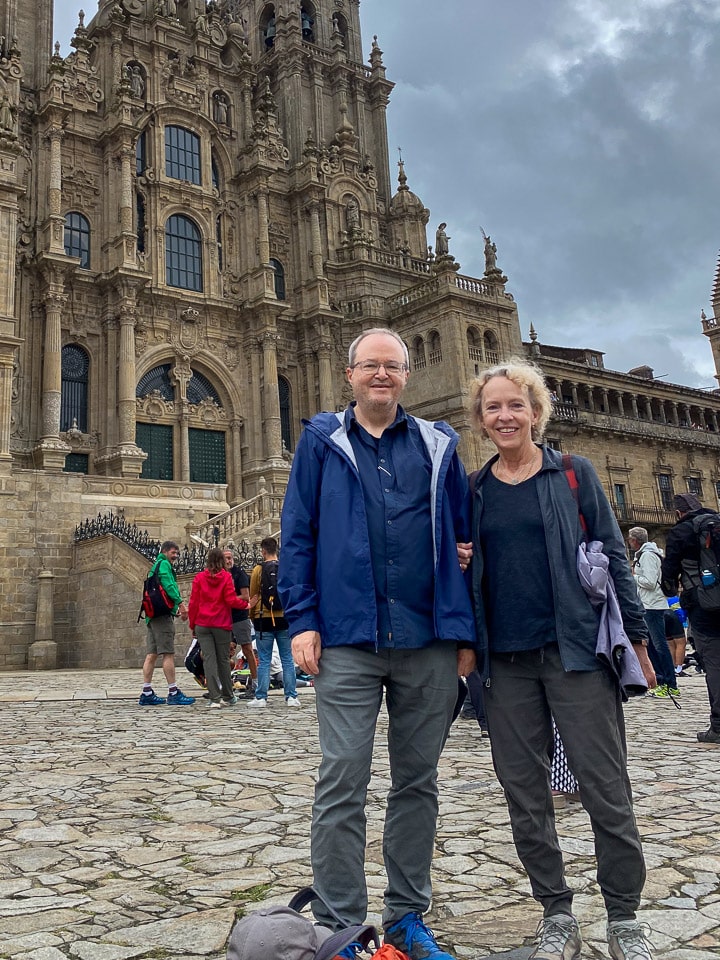
Up Your Travel Skills
Looking to book your next trip? Use these resources that are tried and tested by us. First, to get our best travel tips, sign up for our email newsletter. Then, be sure to start your reading with our Resources Page where we highlight all the great travel companies and products that we trust. Travel Accessories: Check out our list of all the accessories we carry to make getting there and being there a lot easier. Credit Cards: See our detailed post on how to choose the right travel rewards credit card for you. Flights: Start finding the very best flight deals by subscribing to Thrifty Traveler. Book your Hotel: Find the best prices on hotels with Booking.com. See all of the gear and books we like in one place on our Amazon shop.Got a comment on this post? Join the conversation on Facebook, Instagram, or Threads and share your thoughts!

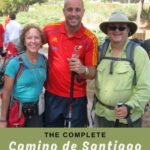
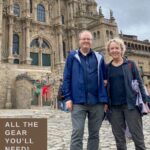
Comments are closed.